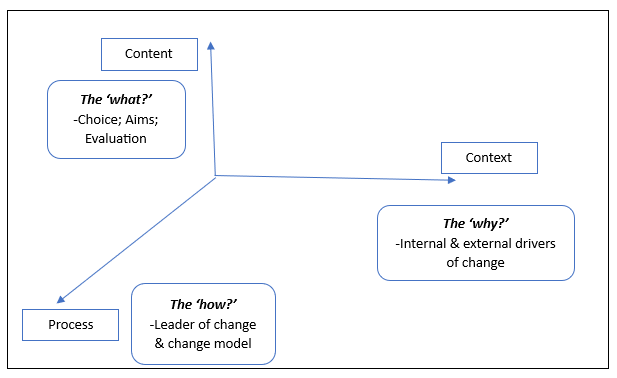Introduction to leaders and change management
Part 1 introduced two linear models of change: Lewin’s Unfreeze-Change-Refreeze model and the N-step model. These are easy to follow. However, these are not the only models to support leaders manage change successfully.
Part 2 will introduce other change models which pay attention to different perspectives and values, which helps our understanding of change. Leaders can choose a model most appropriate to them as a leader and to the change in hand.
Bite Size ‘Simple Steps’ (TLDR) – 4 Steps to Implementing Change Management in a Marketing Agency – Read part 1 for the first 4 steps
5. Empower Employees for Broad-Based Action
- Explanation: Remove barriers and empower employees to take initiative and contribute to the change process. This involves providing the necessary resources, training, and support.
- Example: The agency invests in training programs for employees to learn new digital marketing tools and techniques. They also create a platform for employees to share ideas and collaborate on projects.
6. Generate Short-Term Wins
- Explanation: Identify and celebrate small, early successes to build momentum and demonstrate the benefits of the change. These wins help to motivate and keep the team engaged.
- Example: The agency sets short-term goals, such as successfully launching a data-driven marketing campaign for a key client. They celebrate these achievements through company-wide announcements and rewards.
7. Consolidate Gains and Produce More Change
- Explanation: Use the credibility from early wins to drive more change. This step involves continuously improving processes, addressing challenges, and sustaining the momentum.
- Example: After initial successes, the agency expands the use of AI tools to other clients and refines its strategies based on feedback and performance data, ensuring the changes are deeply embedded.
8. Anchor New Approaches in the Culture
- Explanation: Ensure the changes are sustained by embedding them into the organizational culture. This involves aligning new behaviors with organizational values and creating lasting improvements.
- Example: The agency integrates digital marketing innovation into its core values, regularly updates training programs, and adjusts performance metrics to reflect the new approaches.
Change management tools to assist leaders develop skills, knowledge, and behaviours
The following three models of change are introduced and shared to provide an alternative to the linear models explored in Part 1. They can be used on their own, with one another and with the linear models of change.
Beer & Nohria’s Theory E & Theory O
Beer and Nohria’s model below identifies ‘hard’ economic philosophies – The ‘E’ stands for Economic value; and ‘softer’ ideas around developing capability within an organisation = ‘O’ is organisational capability. These are identified under key dimension of change headings.
| Dimension of Change | Theory E (Hard) | Theory O (Soft) | Combined E & O |
| Goals | Maximise value | Develop organisational capabilities | Embrace the contradiction between value and capability |
| Leadership | Top-down change | Encourage bottom-up participation | Set direction from top and engage below |
| Focus | Emphasis structure and systems | Develop behaviours and attitudes to improve culture | Focus on both systems and culture |
| Process | Plan/ establish programs | Experiment and evolve | Plan for spontaneity |
| Reward System | Motivate through financial incentives | Motivate through commitment | Incentives to reinforce change but not drive it |
| Use of Management Consultants | Management Consultants analyse, identify and shape solutions | Management Consultants support managers to analyse, identify and shape solutions | Management Consultants empower employees |
Leaders can use this model to consider the different ‘hard’ and soft’ aspects and how these can then be combined to support the change process. Not all dimensions of change may be relevant. For example, it is likely that most change will take place with the use of management consultants.
However, the key is to consider the ‘E’ and the ‘O’ for all relevant aspects for the change you are leading. Having done this, consider how the ‘E’ and the ‘O’ for each dimension can complement one another.
There is no right or wrong time to use this model of change and even if you follow a different change model such as the N-step linear model, these principles can still be applied to aid understanding and ultimately assist the change process.
Dunphy and Stace’s Contingency model of leadership and change (1993)
The contingency model below suggests that different situations require different approaches. There are four categories. Leaders need to be aware of developments, threats and opportunities to them and their organisation to use this model. Leaders then need to choose the correct category for their change.
| Incremental change strategies | Transformative change strategies | |
| Participative evolution | Charismatic transformation | |
| Collaborative-consultative modes | For minor adjustments to meet external threats and opportunitiesTime available and support from key stakeholders | For major adjustmentsLittle time with support for change |
| Forced evolution | Dictatorial transformation | |
| Directive-coercive modes | Minor adjustments requiredTime available but key stakeholders oppose change | For major adjustmentsNo time for participationNo support but change is necessary to survive |
Start with the bullet point narrative in the box to decide which of the following approach to take:
- Participative evolution for incremental change requiring collaboration
- Forced evolution for incremental change requiring a direct approach
- Charismatic transformationfor transformative change requiring collaboration
- Dictatorial transformationfor transformative change requiring a direct approach
Although choosing the correct category is subjective, this does provide guidance for the leader of change. However, it may be too simplistic assuming that all scenarios fit neatly into one of the four approaches. There is also an assumption that the change leader has the skills and ability to adapt their approach to each approach.
Using the model can help the leader of change to consider what is required to make a successful change and the approach they take.
Pettigrew and Whipp’s three components of change (1993)
Following the Pettigrew and Whipp (1993) model of change allows leaders of change to think in terms of three components: content – what choices are there? What are you trying to achieve and how will you evaluate the change?; context – what internal and external drivers are there for the change?; and process – the leader themselves and the change model they follow.

The assumption here is that change is complex with all three aspects being interrelated. There is no hierarchy with all three aspects of equal importance.
Summary of Change management tools used to assist leaders develop skills, knowledge, and behaviours
As well as linear models of change, you have been introduced to three non-linear models of change.
Part 1 deliberately started with the easiest model to follow. This was built upon with the N-step model, before introducing three more complex models of change. Critics may argue that these three models are too complicated. However, complexity of tools is specific to the situation and the relative experience, confidence, and capability of the leader of change.
Being familiar with different models of change can help leaders to understand change, provide guidance on approach and help them to think and reflect on their change. Ultimately, this will increase the chances of successful change.
Gain experience by leading change, apply these models, and reflect and learn as you do so. No one approach suits all leaders or change situations. Adapt your approach as a leader of change and adopt different change models specific to your needs.
References
Beer, M. and Nohria, N. (2000) ‘Cracking the Code of Change’, Harvard Business Review, May- June, pp 133-141
Dunphy, D.C. and Stace, D.A (1993) ‘The strategic management of corporate change’, Human Relations, vol. 36, no.8, pp 905 -918
Pettigrew, A. and Whipp, R. (1993) Managing Change for competitive success, Oxford, Wiley-Blackwell





